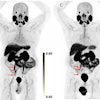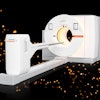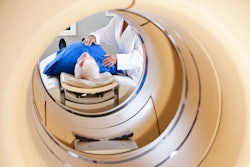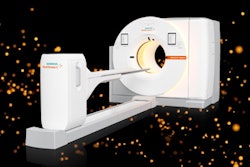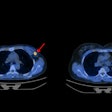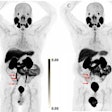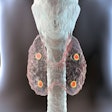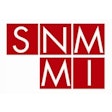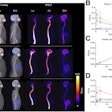A new PET radiotracer shows promise for diagnosing triple-negative breast cancer, researchers at Fudan University Shanghai Cancer Center in China have reported.
In a “bench-to-first-in-human” study, the group found that the tracer was highly accurate at identifying tumors that express Nectin cell adhesion molecule 4 (nectin-4), an emerging biomarker for cancer diagnosis and therapy.
“This radiotracer provides a noninvasive approach to the assessment of nectin-4 and a potential basis for the development of nectin-4-targeted treatments for [triple-negative breast cancer],” noted first author Li Sun, MD, and colleagues. The study was published February 13 in the Journal of Nuclear Medicine.
Triple-negative breast cancer (TNBC) accounts for up to 20% of breast cancer cases and is one of the most aggressive subtypes, with a five-year survival rate of approximately 40%. Nectin-4 has been identified as a treatment biomarker for TNBC, given that the protein is overexpressed in tumors and has relatively low levels in normal tissue, the researchers explained.
Moreover, a nectin-4-targeted radiotracer was recently developed that shows good sensitivity and specificity for identifying tumors in patients with advanced urothelial carcinoma, they noted. To further explore the promise of these radiotracers, the group synthesized three nectin-4-targeted radiotracers labeled with gallium-68 (Ga-68) and tested them in vitro and then in a pilot study in patients with TNBC.
Cellular studies showed that one of the three, Ga-68 FZ-NR-1, was taken up by tumors at the highest rates, while micro-PET/CT mice studies showed that the tracer could target nectin-4 without toxic effects. Thus, the group selected it for testing in nine patients.
 Ga-68 FZ-NR-1 PET/CT images and F-18 FDG PET/CT and PET/MRI images in representative nectin-4-positive TNBC patients. (A) PET/CT images and nectin-4 immunohistochemistry (IHC) staining of patient 1. Maximum-intensity projection (MIP) images and axial and coronal PET/CT images of Ga-68 FZ-NR-1 and F-18 FDG both showed high uptake in lung metastases (arrow). (B) PET/CT images and nectin-4 IHC staining of patient 2. MIP images and axial and coronal PET/CT images of Ga-68 FZ-NR-1 showed high uptake in recurrence of right breast cancer after surgery (arrow), and those of F-18 FDG PET/MRI showed high uptake. Image courtesy of the Journal of Nuclear Medicine.
Ga-68 FZ-NR-1 PET/CT images and F-18 FDG PET/CT and PET/MRI images in representative nectin-4-positive TNBC patients. (A) PET/CT images and nectin-4 immunohistochemistry (IHC) staining of patient 1. Maximum-intensity projection (MIP) images and axial and coronal PET/CT images of Ga-68 FZ-NR-1 and F-18 FDG both showed high uptake in lung metastases (arrow). (B) PET/CT images and nectin-4 IHC staining of patient 2. MIP images and axial and coronal PET/CT images of Ga-68 FZ-NR-1 showed high uptake in recurrence of right breast cancer after surgery (arrow), and those of F-18 FDG PET/MRI showed high uptake. Image courtesy of the Journal of Nuclear Medicine.
According to the analysis, Ga-68 FZ-NR-1 PET/CT visualized tumors in all patients. In one patient with TNBC that had metastasized, Ga-68 FZ-NR-1 PET/CT revealed multiple lung lesions with notable uptake of the tracer, the group noted. They confirmed this with standard F-18 FDG PET/CT imaging, which also showed multiple metastatic lesions in both lungs, with a subsequent comparison between the techniques showing that Ga-68 FZ-NR-1 PET/CT was more accurate, the group reported.
Importantly, there were no reports of serious adverse events or notable changes in vital signs in patients one week after imaging, the group noted.
“Despite the limited patient data, the preliminary findings suggest that Ga-68 FZ-NR-1 is an effective tracer for identifying patients with positive nectin-4 expression,” the researchers wrote.
While to date just one drug that targets nectin-4 in urothelial carcinoma (enfortumab vedotin, Padcev) has been approved by the U.S. Food and Drug Administration, others are in development, including in patients with breast cancer, the researchers added. Thus, with further development in larger trials, Ga-68 FZ-NR-1 could play a significant clinical role, they suggested.
“This technology may allow the accurate analysis and quantification of nectin-4 expression, which could be of value for patient diagnosis, for guiding treatment options, and for disease monitoring,” the group concluded.
The full study is available here.


